Schema Domain: Disconnection And Rejection


What’s new?
Our schema series includes six information handouts which provide detailed explanations of schemas within the ‘disconnection and rejection’ domain.
Schema therapy
Schema therapy is an evidence-based, integrative therapy developed for treating complex and longstanding difficulties. It is based on the idea many psychological and relational problems stem from early maladaptive schemas (EMS) and how individuals cope with them. Schema therapy expands on CBT by exploring the developmental origins of psychological problems and addressing the maladaptive ‘coping styles’ that perpetuate them.
Schema therapy concepts can be difficult for clients to grasp. Here, we introduce our first set of information handouts for schemas belonging to the disconnection and rejection domain.
Disconnection and rejection domain
Jeffrey Young (1990) originally described 15 schemas, which were later expanded to 18 (Young et al., 2003). These schemas were grouped into hypothetical ‘schema domains’, each associated with specific unmet emotional needs. Initially, these domains were disconnection and rejection, impaired autonomy and performance, impaired limits, other-directedness, overvigiliance, and inhibition (Young et al., 2003). However, subsequent research has suggested a more parsimonious categorisation of four schema domains (Bach et al., 2018; Hoffart et al., 2005; Mącik & Mącik, 2022). These refined domains are disconnection and rejection, excessive responsibility and standards, impaired autonomy and performance, and impaired limits.
Schemas in the disconnection and rejection domain are associated with the expectation that one’s needs for affection, safety, empathy, belonging, respect, emotional expression, and spontaneity will not be met. Each of these schemas is described below.
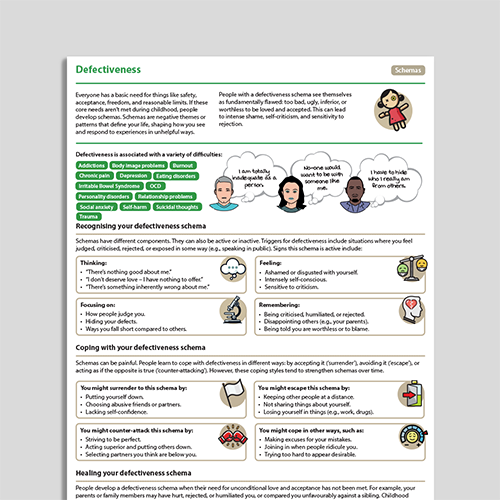
Defectiveness
Individuals with a defectiveness schema experience a pervasive sense of inadequacy and inferiority. They see themselves as fundamentally flawed and defective, leading to feelings of shame and unworthiness. Research suggests that this is one of the most pronounced early maladaptive schemas across psychological disorders.
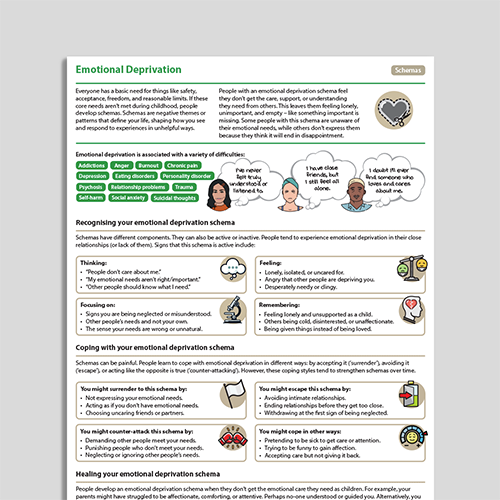
Emotional Deprivation
Individuals with an emotional deprivation schema anticipate that other people will not provide the support, understanding, and guidance they want and need. As a result, individuals with this EMS often feel uncared for, or disappointed with their relationships. They also long for emotional connection. Young and colleagues (2003) suggest that this is one of the most common EMS, although people are often unaware that it is relevant to them.
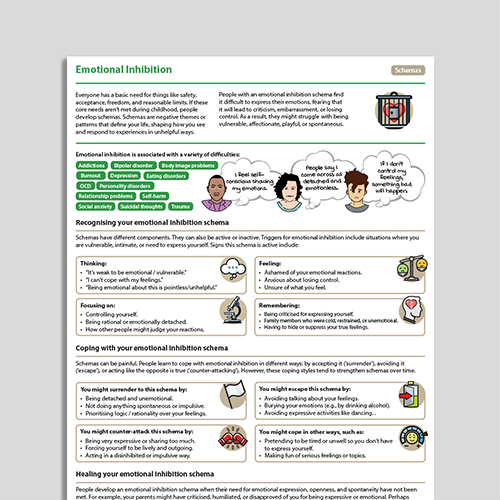
Emotional Inhibition
People with an emotional inhibition schema tend to hide or suppress their spontaneous emotional expressions, actions, and communications. As a result, they might come across as detached, overly controlled, impersonal, or emotionally flat. Emotional inhibition was initially grouped with EMS in the ‘overvigilance and inhibition’ domain (Young et al., 2003), which is characterized by the suppression of spontaneous feelings and impulses, and the pursuit of demanding, internalized standards. However, it was subsequently recategorized into the ‘disconnection and rejection’ domain, which relates to difficulties forming secure attachments and the expectation that one’s basic emotional needs (e.g., connection, acceptance, and understanding) will not be met (Bach et al., 2018; Young, 2014).
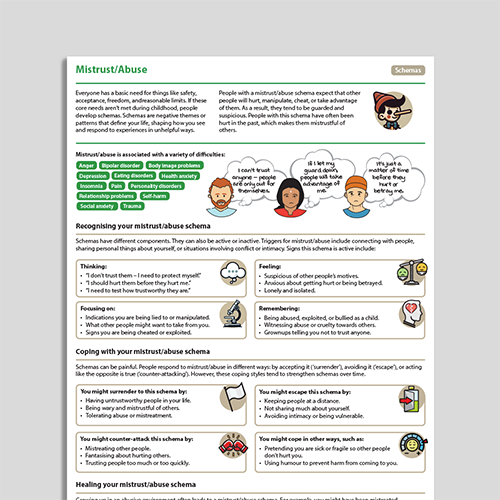
Mistrust/Abuse
People with a mistrust/abuse schema expect that other people will hurt, manipulate, cheat, or take advantage of them. As a result, they tend to be guarded and suspicious. People with this schema have often been hurt in the past, which has made them mistrustful of others.
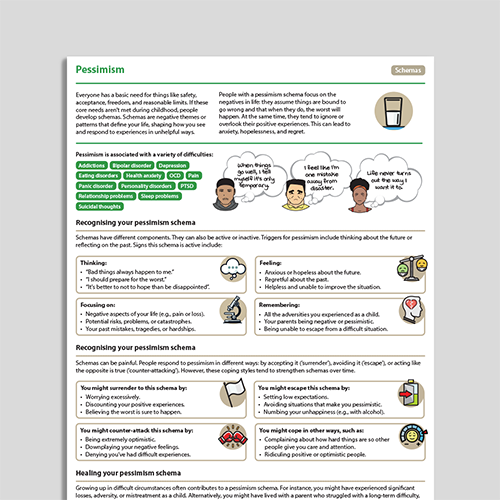
Pessimism
People with a pessimism schema focus on the negatives in life: they assume things are bound to go wrong and when they do, the worst will happen. At the same time, they tend to ignore or overlook their positive experiences. This can lead to anxiety, hopelessness, and regret. Pessimism (previously referred to as ‘negativity/ pessimism’) was originally grouped with EMS in the ‘overvigilance and inhibition’ domain (Young et al., 2003). However, subsequent research indicates that it is better categorized in the ‘disconnection and rejection’ domain (Bach et al., 2018), as it is characterized by the expectation that one’s need for support, safety, stability, and spontaneity will not be met.
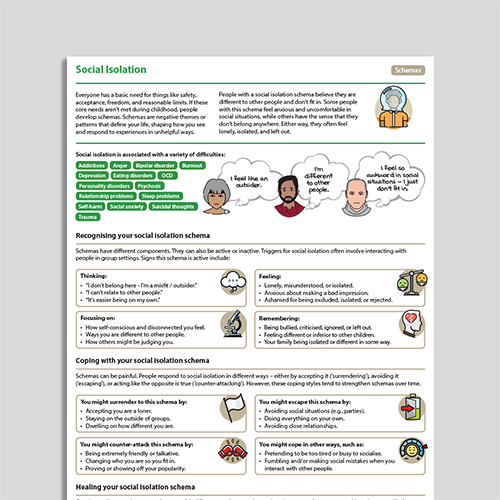
Social Isolation
People with a social isolation schema believe they are different to other people and don’t fit in. Some people with this schema feel anxious and uncomfortable in social situations, while others have the sense that they simply don’t belong. Either way, they often feel lonely, isolated, and left out. Social isolation has been previously referred to as ‘social isolation/alienation’ and ‘social exclusion’ (Young & Klosko, 1994; Young et al., 2003).
References
- Bach, B., Lockwood, G., & Young, J. E. (2018). A new look at the schema therapy model: organization and role of early maladaptive schemas. Cognitive Behaviour Therapy, 47, 328-349. DOI: 10.1080/16506073.2017.1410566.
- Hoffart, A., Sexton, H., Hedley, L. M., Wang, C. E., Holthe, H., Haugum, J. A., Nordahl, H. M., Hovland, O. J., & Holte, A. (2005). The structure of maladaptive schemas: A confirmatory factor analysis and a psychometric evaluation of factor-derived scales. Cognitive Therapy and Research, 29, 627-644. DOI: 10.1007/s10608-005-9630-0.
- Mącik, D., & Mącik, R. (2022). Are four maladaptive schema domains a better option than five? Recommendations based on comparison of the latent structure of schemas on a large group of healthy adults. Behavioural and Cognitive Psychotherapy, 50, 334-344. DOI: 10.1017/S1352465821000539.
- Young, J. E. (1990). Cognitive therapy for personality disorders: A schema-focused approach. Practitioner’s Resource Exchange.
- Young, J. E. (2014). Early maladaptive schemas. Schema Therapy Institute, New York.
- Young, J. E., & Klosko, J. S. (1994). Reinventing your life: The breakthrough program to end negative behavior and feel great again. Plume.
- Young, J. E., Klosko, J. S., & Weishaar, M. E. (2003). Schema therapy: A practitioner’s guide. Guilford Press.
